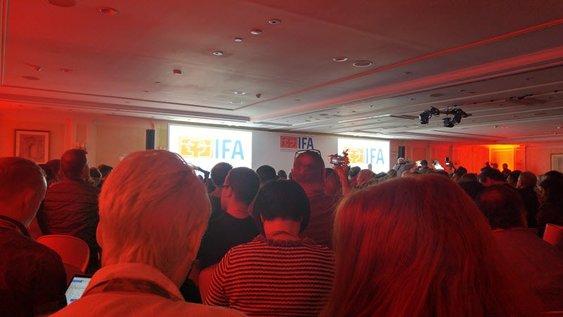|
Today was (finally) the first day of the IFA Global Press Conference. This is the same organization that runs the big tech event each September in Berlin that I write about, but it’s a very different fish. Much smaller and it’s largely what it says it is – there are a few products displayed, but mostly is a series of press conferences and panels. Plus one-on-one interviews for thems that wants them. I didn’t since that’s not generally what I do. In fact, I generally don’t go to press conferences, finding most of them largely self-promotion, so I prefer to focus on the products themselves. That pretty much held here, though there were a few interesting presentations about the future of tech – mostly focused on Europe -- and a couple intriguing products. I won’t go into great detail here since I’ll be getting into it in much more detail in an upcoming article for my The Writers Workbench article on the Writers Guild of America website (which I’ll link to here), but also I’m a bit rushed at the moment since, as tends to happen at this point, it’s fairly late at night here in Lisbon. One product that stood out was The Frame from Samsung. Basically, it's a wall-mounted TV set with no cables (it makes Bluetooth connections) -- and when you're not using it as a TV it goes into Art Mode and will display your digital art or art created for Samsung by artists on assignment. It will be available in Europe the end of May and then rolled out across the rest of the world after that. The 55" model will cost 2,195 Euros, which is around $2,400, though sometimes products cost less here. There will also be a 65" model. I was also intrigued by the talk given by Paul Gray, the principal consumer electronics analyst from IHS Technologies. One thing he was talking about was the next generation of Internet connection for mobile devices, 5G. It's not ready yet though is currently in testing phase and is expected to be ready in 2020, if everything gets worked out. The "if" is the operative term. But "if" so, it will be at least 100 times faster than current speeds, with some applications as much as 300 times fast. If. What this means with a massively bigger pipeline is that the whole platform for streaming is changed, which is why content and service provider companies are forming alliances. Streaming movies to your tablet, phone or even smart TV will now be a completely viable alternative to studio and network product, even far more so than today. This is worth noting in particular because of the current WGA-AMPTP negotiations, something I mentioned to Paul Gray after the event, and he thought it a valid point. What I was referring to is that in the last WGA strike in 2008, one of the issues was monetizing work on the Internet, and studios disingenuously tried to claim that they didn't know if there would be money in it -- and so, they kept offering the writers zero. It was so appalling that eventually companies like Amazon, Netflix and Hulu said, "Hey, we're not signatories to the Minimum Basic Agreement, so if you writers want to sign deals with us to make projects, we'll give you much more control over the work." The point here is that up until then, studios and networks had no competition. They were the only outlet for the movie and TV work. But because they were so egregiously greedy and offered zero, they opened the door to actual competition. And now that 5G with speeds 100 times faster (up to 300 times faster) in the possible, that door may well be flung open wide. And the studios and networks only have themselves to blame. More on IFA GPC tomorrow, the final day of the show. I'll be home on Sunday, which I mention because it gives the elves taking care of the homestead a few days to clean up...
0 Comments
Leave a Reply. |
AuthorRobert J. Elisberg is a political commentator, screenwriter, novelist, tech writer and also some other things that I just tend to keep forgetting. Feedspot Badge of Honor
Categories
All
|
|
© Copyright Robert J. Elisberg 2024
|







 RSS Feed
RSS Feed